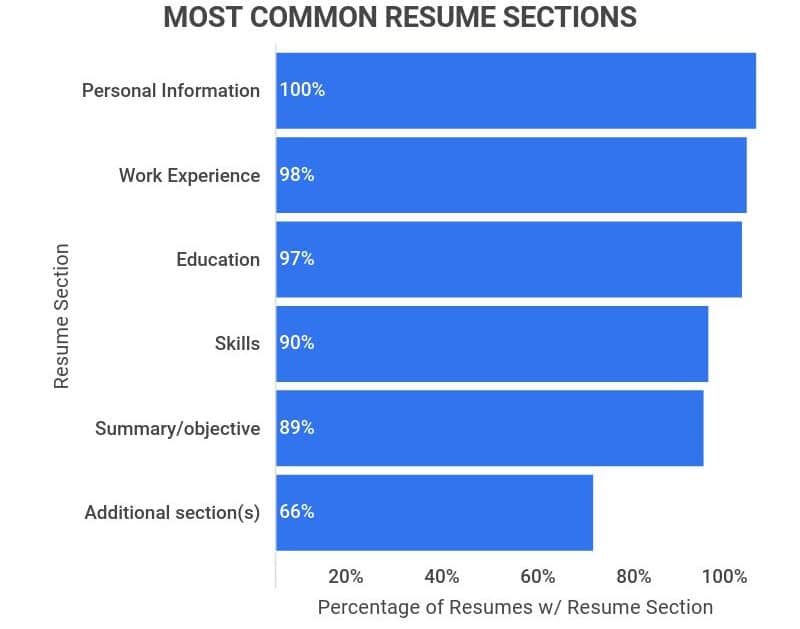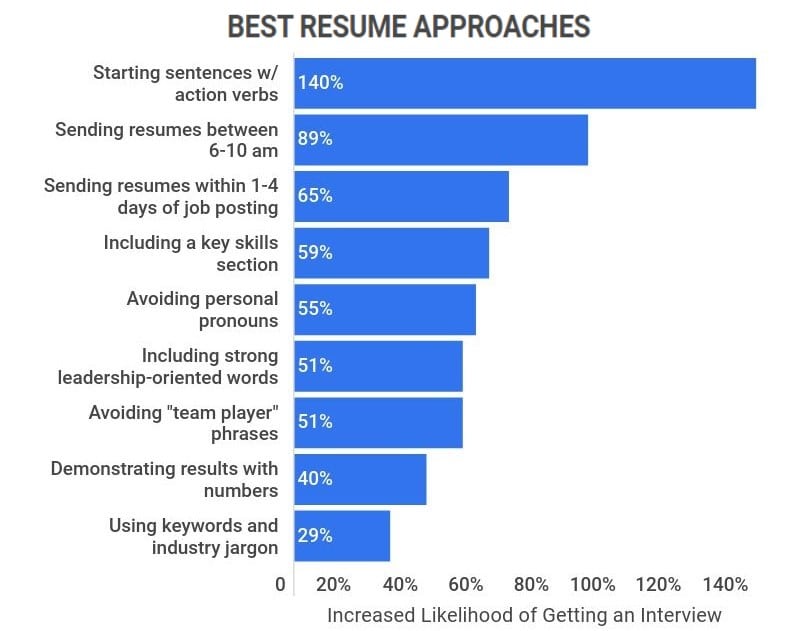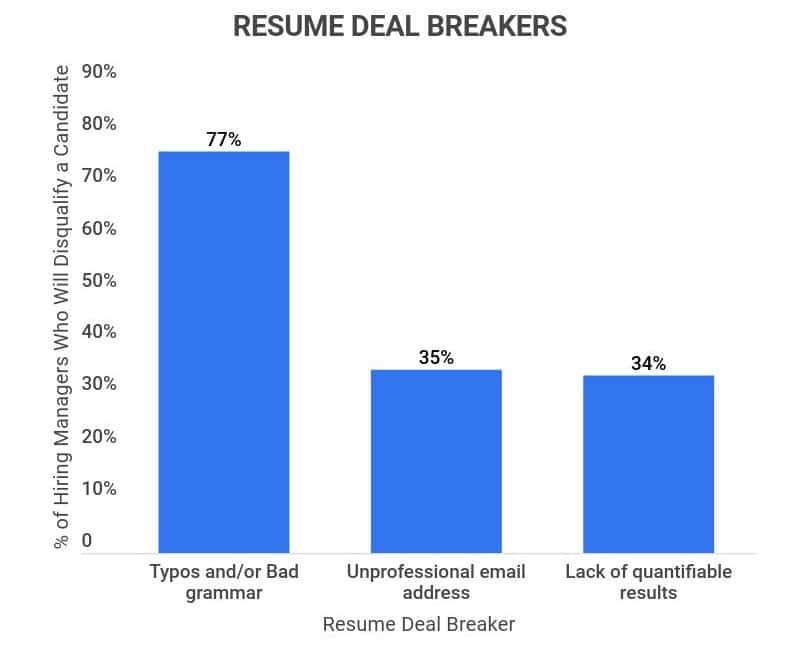- Job Seeker Statistics
- Career Change statistics
- Internship Statistics
- Job Search Statistics
- Average Number Of Jobs Applied
- Average Salary Increase When Changing Jobs
- Part Time Job Statistics
- Age Discrimination Statistics
- Networking Statistics
- Interview Statistics
- Average Number of Jobs In A Lifetime
- Teacher Statistics
- Resume Statistics
Reseach Summary. Each job opening can receive hundreds of applications, so you might need to send dozens before being accepted for an interview. This is why it’s a good idea to have a professionally written resume and tap into your professional network to improve your chances of getting hired. After extensive research, our data analysis team concluded:
-
Online job openings receive 250+ resumes, each. IT job openings receive an average of 386.
-
Hiring managers spend an average of 6 seconds reading a resume.
-
Only about 2% of sent resumes result in an interview.
-
On average, you need to send between 30 and 50 resumes to get hired.
-
10% of job seekers have applied for 50 or more jobs without hearing back.
-
60% of jobs are found via networking instead of through websites that post job listings.
-
Referred candidates are twice as likely to land an interview and have a 40% better chance of getting hired.
-
A professionally written resume boosts your earning potential by 7%.
-
68% of job seekers who have contracted with a professional resume writer find a new role in under 90 days.
-
65% of recruiters claim talent shortage is the biggest challenge in finding candidates.
For further analysis, we broke down the data in the following ways:
Formatting | Rejection | Cover Letters | Social Media | Job Title

Resume Formatting Statistics
Recruiters and hiring managers don’t spend a lot of time looking at each resume, so it’s essential to create one that’s simple, clear, customized, and logically laid out. If you’re a seasoned employee, you might also consider a two-page resume.
-
The average resume is 489 words long, with 380 words being roughly the single-page resume cutoff point.
-
Nearly one-quarter (24%) of hiring managers spend less than 30 seconds looking at a resume.
-
63% of recruiters want to receive resumes tailored to the open position, which entails creating a new resume for each job application.
-
According to an eye-tracking study, the resumes that are most likely to get noticed by recruiters share the following characteristics: A clear, simple resume that uses logical layouts, an overview at the top (like a summary or objective section), and the use of clear, legible fonts.
-
77% of employers say seasoned workers should not use a single-page resume.
-
Data shows that recruiters are 2.9x more likely to pick a candidate with a two-page resume for managerial roles and 1.4x more likely for entry-level positions.
-
At the same time, a two-page resume is a deal-breaker for 17% of hiring managers.
-
Not using a list of professional skills can hurt a resume as much as one year of unemployment.
-
It’s best practice to use a heading statement focused on what you’ll bring to the table.
-
Most contemporary job seekers use at least one “additional” resume section to back up their qualifications.
-
61% of hiring managers consider a customized resume the number one tactic for applicants to boost their chance of getting a job. This includes attaching a cover letter, addressing the hiring manager by name, linking to an applicant’s online portfolio, blog, or website.
-
But keep in mind that 40% of recruiters are put off by too much resume design.
-
The most efficient resume approaches include starting sentences with action verbs (140%), sending resumes between 6 a.m. and 10 a.m. (89%), sending resumes within one to four days of the job posting (65%), including a key skills section (59%), avoiding using personal pronouns (55%), including strong and leadership-oriented words (51%), avoiding “team player” phrases (51%), demonstrating results with numbers (40%), and using keywords and industry jargon (29%).
-
The description on a job opening contains an average of 21.8 skills, while resumes list only 13 skills on average.
-
Studies have shown hiring managers respond more positively to resumes that lack ethnic details.
-
77% of employers believe that soft skills are important. 16% believe that they are more important than hard skills.
-
43% of resumes are submitted in an incompatible file type.


| Cliche | Percent of Recruiters That Hate it |
|---|---|
| Work independently | 47% |
| Hard Worker | 42% |
| Work well under pressure | 39% |
| Good communicator | 36% |
| Enthusiastic | 35% |
| Team player | 32% |
| Good listener | 28% |
| Excellent written communication skills | 24% |
| Proactive | 22% |
| Good problem solver | 19% |
Resume Rejection Statistics
Most resumes don’t make it past applicant tracking system (ATS) software. Those that do are often rejected because of impersonal applications, no thank you note, and lack of customization for the job role.
-
Up to ¾ of large companies (and about 98.8% of Fortune 500 companies) use an applicant tracking system (ATS) to automatically sort, scan, and rank resumes for keywords, and most resumes don’t make it past this software.
-
Up to ¾ of qualified applicants have been rejected by an applicant tracking system (ATS) because the software couldn’t read their resumes.
-
5% of applicants are dishonest when describing their previous roles or their time spent in a job. 75% of human resources managers have caught a lie on a resume.
-
Most recruiters spend an average of 3.14 minutes reading a candidate’s resume, and they have generally made up their minds within the first minute. 40% of hiring managers spend less than a minute reviewing a resume.
-
59% of recruiters will reject a candidate because of poor grammar or a spelling error.
-
Over 50% of recruiters will reject a candidate if their resume is full of cliches.
-
1 in 5 recruiters will reject a candidate before they’ve even finished reading their resume.
-
The top resume deal breakers for hiring managers include: Typos or bad grammar (77%), Unprofessional email address (35%), Lack of quantifiable results (34%).
-
According to recruiters, the top reasons for rejecting a resume are the following: impersonal applications (84%), no thank you note (57%), and lack of resume customization (54%).
-
36% of resumes are rejected for being too generic, 35% for not listing skills, 32% that copy excessive wording from the job description, 27% that don’t include exact dates of employment, and 13% that include a photo.

Resume Statistics Related to Cover Letters
Cover letters are essential for job search success, which is why nearly half of job seekers write them, and almost as many recruiters reject applications without them.
-
Nearly half (47%) of job seekers write cover letters.
-
Over ¼ (26%) of recruiters always read cover letters and think they are important to make a hiring decision.
-
Up to 38% of hiring managers say that including a cover letter makes them more likely to pay attention to the application.
-
Almost half (45%) of recruiters say that not having a cover letter could get your job application rejected.
-
Nearly 70% of employers prefer cover letters that are ½ page or less.
Resumes and Social Media Statistics
Social media profiles are a vital part of the job application process, especially if your resume passes an ATS system and lands in front of a recruiter or hiring manager.
-
A complete, up-to-date LinkedIn profile is a must-have supplement to your resume since 77% of recruiters rely on the website when searching for qualified candidates.
-
More than 90% of employers use social media in their quest to find new talent.
-
Even if they had a top-quality resume, 54% of employers have rejected candidates based on their social media profiles.
Resume Statistics by Position
Of course, while we can’t cover what you should put on your resume for every industry and job out there, our data does offer a ew tips. According to our research, you’ll want to consider the following for these positions, and others like them:
Accountant
Must-have resume sections include: Personal Information, Education, Work Experience, Skills, and Summary or Objective.
Common additional sections include: Languages, References, Software, Certificates, Interests, Courses, Additional Activities, Legal Clause, Conferences, Licenses, and Publications.
The 10 most common accountant resume skills include:
-
Communication
-
Microsoft Excel
-
Microsoft Office
-
Time Management
-
Quickbooks
-
Teamwork
-
Microsoft Word
-
Problem Solving
-
Accounts Payable/Receivable
-
Adaptability
Administrative Assistant
Must-have resume sections include: Personal Information, Work Experience, Education, Skills, and Summary or Objective.
Common additional sections include: Languages, References, Software, Interests, Certificates, Additional Activities, Courses, Licenses, Conferences, and Publications.
The 10 most common administrative assistant resume skills include:
-
Communication
-
Salesforce
-
Time Management
-
Microsoft Office
-
Customer Service
-
Problem Solving
-
Organization
-
Microsoft Excel
-
Teamwork
-
Microsoft Word
Customer Service Representative
Must-have resume sections include: Personal Information, Work Experience, Education, Summary or Objective, and Skills.
Common additional sections include: Languages, References, Certificates, Interests, Software, Additional Activities, Courses, Licenses, Conferences, and Publications.
The 10 most common customer service representative resume skills include:
-
Customer Service
-
Communication
-
Time Management
-
Problem Solving
-
Teamwork
-
Leadership
-
Adaptability
-
Microsoft Office
-
Multitasking
-
Organization
Data Scientist
Must-have resume sections include: Personal Information, Work Experience, Education, Skills, and Summary or Objective.
Common additional sections include: Certificates, Additional Activities, Languages, Software, Interests, Publications, Courses, References, Conferences, and Licenses.
The 10 most common data scientist resume skills include:
-
Python
-
SQL
-
R
-
Machine Learning
-
Tableau
-
Data Visualization
-
Spark
-
Microsoft Excel
-
SAS
Mechanical Engineer
Must-have sections include: Personal Information, Education, Work Experience, Skills, and Summary or Objective.
Common additional sections include: Languages, Software, Certificates, Additional Activities, Interests, References, Courses, Publications, Licenses, and Conferences.
The 10 most common mechanical engineer resume skills include:
-
SolidWorks
-
Microsoft Office
-
AutoCAD
-
MATLAB
-
Teamwork
-
Leadership
-
Communication
-
Problem Solving
-
ANSYS
-
Project Management
Product Manager
Must-have resume sections include: Work Experience, Personal Information, Education, Skills, and Summary or Objective.
Common additional sections include: Certificates, Software, Languages, Interests, Additional Activities, Courses, References, Publications, Conferences, and Licenses.
The 10 most common product manager resume skills include:
-
Agile
-
Product Management
-
Project Management
-
Leadership
-
JIRA
-
Scrum
-
Problem Solving
-
Strategic Thinking
-
Communication
-
SQL
Project Manager
Must-have resume sections include: Personal Information, Work Experience, Education, Summary or Objective, and Skills.
Common additional sections include: Certificate, Languages, Software, Additional Activities, Interests, Courses, References, Licenses, Publications, and Conferences.
The 10 most common project manager resume skills include:
-
Project Management
-
Communication
-
Leadership
-
Microsoft Office
-
Microsoft Project
-
Problem Solving
-
Time Management
-
Risk Management
-
Strategic Planning
-
PMP Certification
Software Engineer
Must-have resume sections include: Personal information, Work Experience, Education, Skills, and Summary or Objective.
Common additional sections include: Languages, Additional Activities, Software, Certificates, Interests, Courses, References, Publications, Conferences, and Licenses.
The most common software engineer resume skills include:
-
Java
-
Python
-
JavaScript
-
SQL
-
C#
-
C++
-
Git
-
HTML
-
Node.js
-
CSS
Resume FAQ
-
What are 4 common resume mistakes?
The 4 common resume mistakes are typos/bad grammar, submitting a resume that’s not tailored for the job description, failing to include quantifiable results (numbers), and using an unprofessional email address.
Having just one grammatical mistake or typo is enough for up to 20% of hiring managers and recruiters to reject you as a candidate. Fortunately, most of these errors can be avoided through simple proofreading, so be sure to look over your resume a few times before submitting it. Further, having an add-on like Grammarly, or having a friend look over your resume for you, can provide you with even more valuable feedback.
-
Is hiring a resume writer worth it?
Yes, hiring a resume writer is worth it. Professional resume writers typically cost between $200-$500, but with the right service, you can expect a starting salary at least $500 higher than if you wrote your resume without professional help.
-
Is a resume the same as a CV?
No, a resume is not the same as a CV. A curriculum vitae means the “course of one’s life,” and in the US, these professional documents are used by academics, scientists, researchers, and certain government positions.
A CV covers every aspect of an individual’s professional background and typically includes a number of projects, published works, attended conferences, speeches given, etc. A CV also doesn’t usually change based on where an applicant is applying — it is a living document that aims to be completely comprehensive.
A resume is a much shorter document that only covers the candidate’s relevant background and skills. In Europe, the term CV refers to a resume-like document, so if you’re applying for a job abroad that asks for a CV, your regular resume should work (with a few minor tweaks).
-
What should I include in my resume?
Your resume should include sections dedicated to your contact information, work experience, educational background, skills, and a resume summary or objective. Your work experience section should include your job title, the dates you worked there, and major accomplishments from your time working.
Your educational background only needs to cover the basics (your degree, GPA) but can cover additional aspects of your time in school (projects, theses, dissertations, groups, clubs, etc.) if you’re a recent graduate.
Your skills should tie in closely with the required qualifications listed in the job description. Your resume summary statement should list your years of experience in the field and discuss your specific relevant achievements in the past few years.
-
How can I make a resume online?
With Zippia’s resume builder, you can have a great-looking resume in under 15 minutes.
- Job Seeker Statistics
- Career Change statistics
- Internship Statistics
- Job Search Statistics
- Average Number Of Jobs Applied
- Average Salary Increase When Changing Jobs
- Part Time Job Statistics
- Age Discrimination Statistics
- Networking Statistics
- Interview Statistics
- Average Number of Jobs In A Lifetime
- Teacher Statistics
- Resume Statistics
Conclusion
Creating the perfect resume can seem like an essential, yet unreachable task for many Americans. The fact is that online job openings can receive upwards of 250 resumes, which explains why the average hiring manager only spends 6 seconds looking at yours.
However, the situation isn’t as hopeless as it might seem. The fact is that the way you craft your resume can have a significant impact on your likelihood of being hired. Something as simple as starting your resume with action verbs can increase your chances of earning an interview by 140%. That, along with other tips like when to send your resume, and what skills to include on it, can be the true deciding force in whether or not an employer shows interest.
References
The Undercover Recruiter. Top Resume Mistakes That Could Cost You the Job. Accessed 6/1/21.
The Motley Fool. 5 Resume Stats All Job Seekers Should Know. Accessed 6/1/21.
Roane State Community College. 10 Current Resume Trends Forecasts for 2020/2021 You Should Be Thinking About. Accessed 6/1/21.
Resume Valley. Current Resume Trends This 2021: The Future of Job Search. Accessed 6/1/21.





